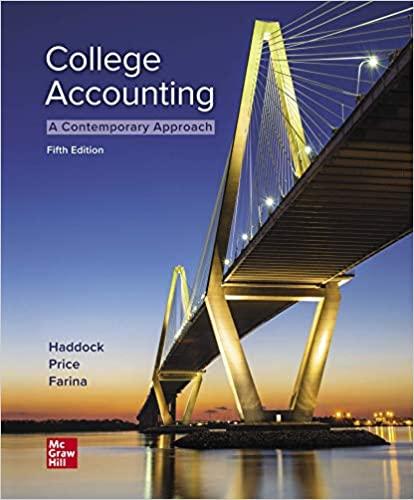Question
Space Shuttle Corp. (SSC) is an innovative privately-held company based in Waterloo (ON). It was founded in January 2009 by a visionary Canadian scientist and
Space Shuttle Corp. (SSC) is an innovative privately-held company based in Waterloo (ON). It was founded in January 2009 by a visionary Canadian scientist and millionaire businessman, Dr. Michael Minuzzi. SSC was a culmination of Michael's dream to unleash private innovation in a sector dominated by large government agencies such as the Canadian Space Agency (CASA). Michael gave up all of his other business interests and dedicated himself to SSC by becoming its founding CEO. SSC's current business model involves providing space travel and delivery services to various private and government entities. SSC designs, develops and manufactures its own rockets and artificial satellites. Not everyone shared Michael's enthusiasm when he started SSC - many business commentators initially laughed it off as a ludicrous venture. However, Nathan Garool, a private equity investor from Toronto was highly impressed by Michael's charisma. Nathan saw a tremendous investment opportunity in SSC and obtained a 25% equity stake (for C$ 150 million). Michael held the remaining equity in SSC.Nathan imposed a requirement - that SSC should provide annual financial statements to him using IFRS and seek his advice and feedback on a yearly basis, especially on important capital projects.
SSC promised high private sector salaries to potential employees and was able to attract highly talented scientists from across the globe to come and work for it. Quite amazingly, SSC successfully built and tested two state-of-the-art rockets (Zeta and Theta) in its very first year of operation. The rockets were fully operational from 2011 onwards. After two years of operating losses, SSC landed quite a few lucrative contracts and turned profitable in 2011. Its 2013 revenues were $200 million, a 75% increase over 2012. SSC's 2013 net profit margin of 60% was very impressive as well. SSC's main customers in 2013 included the US, Canadian and Russian space agencies (for delivery of supplies and carrying astronauts on SSC's rockets to the International Space Station), a large telecom company, and a few wealthy individual space tourists who were keen on undertaking their own personal space adventure journeys.
Nathan's investment has been handsomely rewarded. SSC declared dividends of 20% of its net income for 2012 and 2013. On March 1st 2014, as agreed, Dr. Minuzzi emailed Nathan SSC's draft financial and operational results for 2013. In the same email, Michael highlighted the salient features of SSC's performance, its plans for future growth, and a capital project proposal.
Assume the role of Nathan Garool and comment on the following:
a) Dr. Minuzzi highlighted the fact that 20% of SSC's revenues in 2013 came from two shipments from the Canadian space agency (CASA) to the International Space Station (ISS). He was confident that this would turn into a long-lasting relationship. The email highlighted that CASA hired SSC's Zeta rocket twice during 2013 to ship supplies to ISS. The transit time from launch to delivery is four days. Dr. Minuzzi boasted that between Zeta and Theta, SSC has the capacity to undertake a total of 6 delivery trips per year. In fact, SSC had declined delivery three orders from other space agencies from Asia because SSC would have made an net loss on those trips after considering fixed cost allocations such as salaries and office building depreciation. The Asian space agencies had quoted prices that were 50% lower than CASA and were just sufficient to cover the variable costs of those trips. Minuzzi wrote: "It's only fair that each venture be completely profitable like the others - I cannot ignore my fixed cost allocations just because these countries are poor!"
Question: Provide feedback to Dr. Minuzzi regarding his decision to the decline the orders from Asia. Discuss relevant costs and benefits.
b) Dr. Minuzzi's email also contains a capital project proposal. In particular, Dr. Minuzzi is proposing a purchase of robotic equipment that can save significant costs for his delivery business. In particular, he is debating the installation of one of the following two robotic machines. The machines are available from a supplier in the U.S. and can be imported free of any customs duties into Canada (under the North American Free Trade agreement).

Step by Step Solution
There are 3 Steps involved in it
Step: 1

Get Instant Access to Expert-Tailored Solutions
See step-by-step solutions with expert insights and AI powered tools for academic success
Step: 2

Step: 3

Ace Your Homework with AI
Get the answers you need in no time with our AI-driven, step-by-step assistance
Get Started


